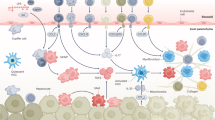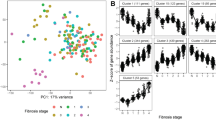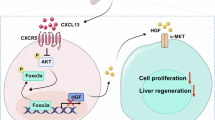Abstract
Non-alcoholic fatty liver disease (NAFLD) is emerging as an epidemic risk factor for hepatocellular carcinoma (HCC). The progression of NAFLD to HCC is closely associated with paracrine communication among hepatic cells. Vascular endothelial growth factor A (VEGFA) plays a key role in NAFLD and HCC; however, the cellular communication of VEGFA in the pathological transition from NAFLD to HCC remains unclear. Here, we found that VEGFA elevation was considerably distributed in hepatocytes of clinical and murine NAFLD-HCC specimens. Notably, progression from NAFLD to HCC was attenuated in hepatocyte-specific deletion of Vegfa (VegfaΔhep) mice. Mechanistically, VEGFA activated human hepatic stellate cell (HSC) LX2 into a fibrogenic phenotype via VEGF-VEGFR signaling in fatty acid medium, and HSC activation was largely attenuated in VegfaΔhep mice during NAFLD-HCC progression. Additionally, a positive correlation between VEGFA and hepatic fibrosis was observed in the NAFLD-HCC cohort, but not in the HBV-HCC cohort. Moreover, LX2 cells could be activated by conditioned medium from NAFLD-derived organoids, but not from HBV livers, whereas this activation was blocked by a VEGFA antibody. In summary, our findings reveal that hepatocyte-derived VEGFA contributes to NAFLD-HCC development by activating HSCs and highlight the potential of precisely targeting hepatocytic VEGFA as a promising therapeutic strategy for NAFLD-HCC.
Similar content being viewed by others
Log in or create a free account to read this content
Gain free access to this article, as well as selected content from this journal and more on nature.com
or
Data availability
The data that supports the findings of this study could be available from the corresponding author upon reasonable request.
References
Friedman SL, Neuschwander-Tetri BA, Rinella M, Sanyal AJ. Mechanisms of NAFLD development and therapeutic strategies. Nat Med. 2018;24:908–22.
Adams LA, Lymp JF, St Sauver J, Sanderson SO, Lindor KD, Feldstein A, et al. The natural history of nonalcoholic fatty liver disease: a population-based cohort study. Gastroenterology. 2005;129:113–21.
Wang X, Zheng Z, Caviglia JM, Corey KE, Herfel TM, Cai B, et al. Hepatocyte TAZ/WWTR1 promotes inflammation and fibrosis in nonalcoholic steatohepatitis. Cell Metab. 2016;24:848–62.
Lefere S, Van de Velde F, Hoorens A, Raevens S, Van Campenhout S, Vandierendonck A, et al. Angiopoietin-2 promotes pathological angiogenesis and is a therapeutic target in murine nonalcoholic fatty liver disease. Hepatology. 2019;69:1087–104.
Day CP. From fat to inflammation. Gastroenterology. 2006;130:207–10.
Jou J, Choi SS, Diehl AM. Mechanisms of disease progression in nonalcoholic fatty liver disease. Semin Liver Dis. 2008;28:370–9.
Bertolani C, Marra F. The role of adipokines in liver fibrosis. Pathophysiology. 2008;15:91–101.
Apte RS, Chen DS, Ferrara N. VEGF in signaling and disease: beyond discovery and development. Cell. 2019;176:1248–64.
Bocca C, Novo E, Miglietta A, Parola M. Angiogenesis and fibrogenesis in chronic liver diseases. Cell Mol Gastroenterol Hepatol. 2015;1:477–88.
Corpechot C, Barbu V, Wendum D, Kinnman N, Rey C, Poupon R, et al. Hypoxia-induced VEGF and collagen I expressions are associated with angiogenesis and fibrogenesis in experimental cirrhosis. Hepatology. 2002;35:1010–21.
Miura K, Ohnishi H, Morimoto N, Minami S, Ishioka M, Watanabe S, et al. Ezetimibe suppresses development of liver tumors by inhibiting angiogenesis in mice fed a high-fat diet. Cancer Sci. 2019;110:771–83.
Beraza N, Marques JM, Martinez-Anso E, Iniguez M, Prieto J, Bustos M. Interplay among cardiotrophin-1, prostaglandins, and vascular endothelial growth factor in rat liver regeneration. Hepatology. 2005;41:460–9.
European Association for the Study of the Liver. Electronic address eee, European Association for the Study of the L. EASL Clinical Practice Guidelines: Management of hepatocellular carcinoma. J Hepatol. 2018;69:182–236.
Yilmaz Y, Yonal O, Kurt R, Alahdab YO, Ozdogan O, Celikel CA, et al. Circulating levels of vascular endothelial growth factor A and its soluble receptor in patients with biopsy-proven nonalcoholic fatty liver disease. Arch Med Res. 2011;42:38–43.
Coulon S, Francque S, Colle I, Verrijken A, Blomme B, Heindryckx F, et al. Evaluation of inflammatory and angiogenic factors in patients with non-alcoholic fatty liver disease. Cytokine. 2012;59:442–9.
Tarantino G, Conca P, Pasanisi F, Ariello M, Mastrolia M, Arena A, et al. Could inflammatory markers help diagnose nonalcoholic steatohepatitis? Eur J Gastroenterol Hepatol. 2009;21:504–11.
Wang B, Fu J, Yu T, Xu A, Qin W, Yang Z, et al. Contradictory effects of mitochondria- and non-mitochondria-targeted antioxidants on hepatocarcinogenesis by altering DNA repair in mice. Hepatology. 2018;67:623–35.
Broutier L, Andersson-Rolf A, Hindley CJ, Boj SF, Clevers H, Koo BK, et al. Culture and establishment of self-renewing human and mouse adult liver and pancreas 3D organoids and their genetic manipulation. Nat Protoc. 2016;11:1724–43.
Tsuchida T, Lee YA, Fujiwara N, Ybanez M, Allen B, Martins S, et al. A simple diet- and chemical-induced murine NASH model with rapid progression of steatohepatitis, fibrosis and liver cancer. J Hepatol. 2018;69:385–95.
Kornek M, Raskopf E, Guetgemann I, Ocker M, Gerceker S, Gonzalez-Carmona MA, et al. Combination of systemic thioacetamide (TAA) injections and ethanol feeding accelerates hepatic fibrosis in C3H/He mice and is associated with intrahepatic up regulation of MMP-2, VEGF and ICAM-1. J Hepatol. 2006;45:370–6.
Francque SM, van der Graaff D, Kwanten WJ. Non-alcoholic fatty liver disease and cardiovascular risk: Pathophysiological mechanisms and implications. J Hepatol. 2016;65:425–43.
Ma C, Kesarwala AH, Eggert T, Medina-Echeverz J, Kleiner DE, Jin P, et al. NAFLD causes selective CD4+ T lymphocyte loss and promotes hepatocarcinogenesis. Nature. 2016;531:253–7.
Mederacke I, Hsu CC, Troeger JS, Huebener P, Mu X, Dapito DH, et al. Fate tracing reveals hepatic stellate cells as dominant contributors to liver fibrosis independent of its aetiology. Nat Commun. 2013;4:2823.
McGlynn KA, Petrick JL, El-Serag HB. Epidemiology of hepatocellular carcinoma. Hepatology. 2021;73:4–13.
Su HJ, Kao JH, Tseng TC, Yang HC, Su TH, Chen PJ, et al. Pathologic findings of patients with nonalcoholic fatty liver disease and the impact of concurrent hepatitis B virus infection in Taiwan. J Formos Med Assoc. 2020;119:1476–82.
Barratt SL, Flower VA, Pauling JD, Millar AB. VEGF (vascular endothelial growth factor) and fibrotic lung disease. Int J Mol Sci. 2018;19:1269.
Ntellas P, Mavroeidis L, Gkoura S, Gazouli I, Amylidi AL, Papadaki A, et al. Old player-new tricks: non angiogenic effects of the VEGF/VEGFR pathway in cancer. Cancers. 2020;12:3145.
Yang L, Kwon J, Popov Y, Gajdos GB, Ordog T, Brekken RA, et al. Vascular endothelial growth factor promotes fibrosis resolution and repair in mice. Gastroenterology. 2014;146:1339–50.e1.
Powell EE, Wong VW, Rinella M. Non-alcoholic fatty liver disease. Lancet. 2021;397:2212–24.
Caballero-Diaz D, Bertran E, Penuelas-Haro I, Moreno-Caceres J, Malfettone A, Lopez-Luque J, et al. Clathrin switches transforming growth factor-beta role to pro-tumorigenic in liver cancer. J Hepatol. 2020;72:125–34.
Ordonez R, Carbajo-Pescador S, Prieto-Dominguez N, Garcia-Palomo A, Gonzalez-Gallego J, Mauriz JL. Inhibition of matrix metalloproteinase-9 and nuclear factor kappa B contribute to melatonin prevention of motility and invasiveness in HepG2 liver cancer cells. J Pineal Res. 2014;56:20–30.
Foglia B, Sutti S, Pedicini D, Cannito S, Bocca C, Maggiora M, et al. Oncostatin M, a profibrogenic mediator overexpressed in non-alcoholic fatty liver disease, stimulates migration of hepatic myofibroblasts. Cells. 2019;9:28.
Du K, Hyun J, Premont RT, Choi SS, Michelotti GA, Swiderska-Syn M, et al. Hedgehog-YAP signaling pathway regulates glutaminolysis to control activation of hepatic stellate cells. Gastroenterology. 2018;154:1465–79.e13.
Zhang K, Han X, Zhang Z, Zheng L, Hu Z, Yao Q, et al. The liver-enriched lnc-LFAR1 promotes liver fibrosis by activating TGFbeta and Notch pathways. Nat Commun. 2017;8:144.
Acknowledgements
We gratefully acknowledge the kind giving of Vegfafl/fl mouse from Genentech (S. San Francisco). This study was supported by National Natural Science Foundation of China (81972584, 81988101, 81902904, 81830054, 81872231, 82073411), Shanghai Education Commission (201901070007E00065), Program of Shanghai Academic/Technology Research Leader (20XD1405000), the Clinical Research Plan of SHDC (SHDC2020CR2011A).
Author information
Authors and Affiliations
Contributions
HYW, YC, HS, and MCW conceptualized and designed the study. HS, HY, YTW, HD, QYL, JF, DC, LNG, LC, YY, and YX conducted the experiment and acquired data. HS and HY did the statistical analysis and drafted the paper. YC and HY revised the paper. HYW and YC supervised the experiment and provided funding support. All authors read and approved the final paper.
Corresponding authors
Ethics declarations
Competing interests
The authors declare no competing interests.
Ethics approval
The study has been approved by the Research Ethics Committee of Eastern Hepatobiliary Surgery Hospital, and the informed consent has been obtained. All animal experiments were performed in accordance with the guidelines of the Institutional Animal Care and Use Committee of Second Military Medical University (Shanghai, China).
Rights and permissions
About this article
Cite this article
Shen, H., Yu, H., Li, Qy. et al. Hepatocyte-derived VEGFA accelerates the progression of non-alcoholic fatty liver disease to hepatocellular carcinoma via activating hepatic stellate cells. Acta Pharmacol Sin 43, 2917–2928 (2022). https://doi.org/10.1038/s41401-022-00907-5
Received:
Accepted:
Published:
Issue date:
DOI: https://doi.org/10.1038/s41401-022-00907-5
Keywords
This article is cited by
-
Impaired mitochondrial degradation of CHCHD2 promotes metabolic dysfunction-associated steatohepatitis-related hepatocellular carcinoma by upregulating VEGFA
Oncogene (2025)
-
Network pharmacology-based investigation of the pharmacological mechanisms of diosgenin in nonalcoholic steatohepatitis
Scientific Reports (2025)
-
Vascular endothelial growth factor signaling in health and disease: from molecular mechanisms to therapeutic perspectives
Signal Transduction and Targeted Therapy (2025)
-
EIF4A3-Induced Circ_0059914 Promoted Angiogenesis and EMT of Glioma via the miR-1249/VEGFA Pathway
Molecular Neurobiology (2025)
-
YTHDF1’s grip on CRC vasculature: insights into LINC01106 and miR-449b-5p-VEGFA axis
Cancer Cell International (2024)



